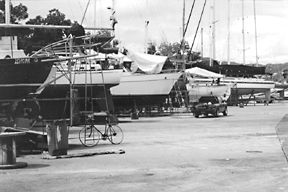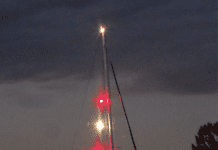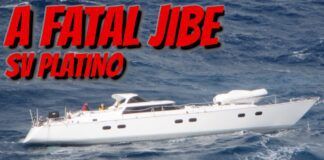Early January found us feverishly preparing to leave Thailand to cross the Indian Ocean. In the next three months, we’ll cover more than 5,000 miles: Thailand to the Maldives (1,600 miles), Maldives to Oman (1,300 miles), Oman to Djibouti (800 miles), and Djibouti to Israel via the Red Sea (1,400 miles).

With the exception of the trip up the Red Sea, each leg of this trip is non-stop. The trip from Thailand to the Maldives will be our second-longest ocean passage, surpassed only by the 3,200-mile trip from the Galapagos to French Polynesia.
We expect to have a fair amount of light air, and a fair amount of more rugged sailing. Actually, the light air can be just as stressful as heavy weather.
There is little chance of finding boat spares over the course of the next few months. What we have on board will have to do the job. Hence, the preparations are a little more intense than usual.
If you think that cruising involves a lot of idle time in port, think again. We have been in Thailand for almost six weeks. Except for a week spent racing in the King’s Cup on Rob Mulderig’s Farr 72 Starr Trail—and the odd trip to the Burmese border to renew our visas, plus a little sightseeing—work on the boat has been non-stop.
You always arrive in port with a long list of things to put right before the next segment of your trip. This is even more true when your next leg involves traveling almost 25% of the circumference of the globe in a short span of time.
To give you an idea of just how many things there are to do, here’s a summary of the more time-intensive jobs we have completed in Thailand.
Cosmetics
We spend a lot of time on cosmetics. There’s a good reason for this. Boats that are well-maintained cosmetically are worth more money in the long run.
In Thailand, we sanded the railcap and applied two more coats of varnish. The three main deck hatch coamings also got two fresh coats of varnish. The two big Dorade boxes over the main cabin were stripped to bare wood and given three starter coats of varnish. Because the Dorades live under fitted canvas covers, this should hold them until we get the chance to apply a few more coats at the next stop.
Any dings in other varnish, such as the cockpit coamings, got appropriate touchup coats.
The topsides were washed, polished and waxed. I hired some local people, at about $12 per day, to help with this.
All the exterior stainless steel and chrome plate, including winches, stanchions, cowl vents and the Monitor windvane, were polished.
The deck structures were detergent washed. The teak decks got washed and bleached, and the deck seams were trimmed flush.
General Maintenance
All cockpit lockers were emptied and reorganized, as was belowdecks storage. Most canvas work was washed and re-waterproofed. Corroded zipper pulls on some canvas were replaced. Canvas was restitched and patched as necessary. Sheets and control lines were washed and inspected. Fenders and fender covers were washed.
Two doors in the head that were binding due to high humidity were refitted. All seawater and freshwater strainers were cleaned. Sticking hinges were freed and oiled.
The filter element was replaced in the galley drinking water system.
All the lifelines and stanchions were removed, cleaned and inspected while we varnished the railcap.
Upgrades
We added a new engine exhaust fitting. Belowdecks, we had a new lee cloth fabricated for the double berth in the forward cabin. We added another Hella fan in the main cabin.
The new television got a permanent mounting system.
We installed a new shower sump (which we had in our supply of spares) after one hose fitting broke off while we were cleaning the sump. This was an anticipated failure, as the sump was accidentally damaged during installation of the watermaker three years ago.
Rig
The rig was gone over from top to bottom. This involved inspection and tightening of every fastening on the mast and boom, inspection of every swage, every fitting, every chainplate, every mast tang, and so on.
The spreader ends were re-taped to reduce chafe. The mainsail track got a fresh treatment with Sailkote to reduce friction when hoisting, lowering and reefing the mainsail.
We replaced the bulb in the masthead tri-color navigation light.
We retuned the rig in anticipation of upwind sailing in heavy air in the Red Sea, increasing bend in the lower section of the mast to reduce pumping and flatten the mainsail slightly. This meant untaping every turnbuckle, removing and replacing every cotter pin, adjusting all the turnbuckles, and re-taping. Of course, we inspected every turnbuckle and toggle closely at the same time.
Engine
The Perkins 4-108 got a lot of attention. We brought in a new spare raw water pump to replace the one that failed en route to Thailand. The new pump and its impeller were greased, new hose adapters and mounting gaskets were fabricated. It’s ready to install immediately in the event of another failure.
Unfortunately, our water pump failure damaged the Speedseal impeller cover that we have used for the last two years, so we had to install conventional covers on both raw water pumps. Just how simple the Speedseal really is was brought home as we struggled with the six tiny screws in each original cover. We will replace the Speedseal as soon as it is practical to do so, as we consider it an essential piece of safety equipment for the engine.
The hose leads to the raw water pump were re-done slightly to improve water flow.
The alignment of both the alternator and the refrigeration compressor was fine-tuned, and a new shim plate was fabricated for the compressor to allow us to increase belt tension. We found a cracked alternator belt, and replaced it. Fortunately, we carry about four spares for each engine belt.
Engine oil and filter were changed. Fuel filters were changed. The transmission was drained and its fluid replaced—an often-overlooked maintenance item.
We checked and burped the PSS Shaft Seal to flush debris from the seal faces.
Every hose clamp on the engine and exhaust system was tightened. Every accessible fastening on the engine was tightened. All the engine mounts were checked and tightened.
We corrected an engine control cable connection that was done incorrectly in New Zealand, freeing up the action of the Morse single-lever engine controls.
A new filter basket was installed in the Groco ARG raw water strainer. This is the third basket in four years. All have failed in exactly the same way, at the spot welds of the handle to the basket. This is getting to be a nuisance—one that other sailors have reported to us as well. (One advantage—or disadvantage—of working for Practical Sailor is that everyone feels obliged to tell you about everything that has gone wrong on his boat. We actually don’t mind this.)
While we had the engine raw water system open, we changed the zinc in the Sea Frost refrigeration condenser. The old zinc was fine, but once it has been pulled out, you might as well replace it.
Finally, we chased down—and, we hope, stopped—several minor oil leaks.
After all this, the engine got a complete wash-down with concentrated Simple Green, followed by a freshwater rinse and a careful wipe-down to remove all traces of oil.
For a finishing touch, the oil pan got fresh “diapers” (oil-absorbing cloths) to keep things clean and dry.
And the Beat Goes On
This is not a complete list of our work in Thailand, but it gives you an idea of what is required on a well-maintained cruising boat.
Actually, it’s not the items on your worklist that slow you down. It’s the “little” things that show up unexpectedly: a cracked belt, a seized fastening, a chafed hose.
And, of course, the list does not include the routine items, such as weekly filling of the water tanks from 20-liter water bottles. The water at outlets in Thailand is non-potable, and the water in many harbors is not clean enough to run the watermaker.
Then, of course, there are the endless trips to the supermarket, stocking up for a long, long passage with unknown supplies of food. Our freezer is stuffed with vacuum-packed steaks, chops, sausages, swordfish, and fresh pasta. The bottom of the fridge is jammed with vacuum-packed Australian brie and cheddar. The bilge is full of Australian wine. We have jar after jar of Skippy Superchunk peanut butter, box after box of UHT milk and orange juice, cases of crackers, cartons of cookies, piles of pasta, prodigious amounts of potatoes, and gobs of garlic.
Somehow you also manage to fit in sightseeing, eating out, socializing with old friends, making new ones ashore and afloat.
Asia has been work, and a lot of fun, too. But it’s time to get to sea again. The Middle East is calling and we’re answering.
Also With This Article
Click here to view “When Old Technology is Better.”









































